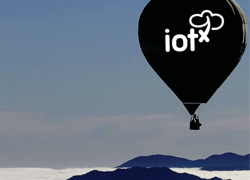Nigel Chadwick is the chief executive of Stream Technologies, which provides its IoT-X platform to companies across the IoT. Here, Chadwick tells IoT Now that, as IoT applications and services proliferate and enter the mainstream, organisations are looking for platforms with the capabilities of IoT-X to enable them to have the widest possible choice of connectivity providers while also supplying the tools they need to manage, operate and charge for service effectively. It’s an exciting time, says Chadwick, as market growth is poised to explode
IoT Now: The super (virtual) network operator (S-(V)NO) is starting to become a reality – can you explain what this is?
Nigel Chadwick: Put simply, IoT-X enables the emergence of the super-virtual network operator – an organisation that relies on networks to support its IoT services but that occupies a layer above the networks themselves and has freedom in terms of the wireless network types it chooses and the network provider brands it consequently selects to transmit data across.

Until now mobile network operators (MNOs) and satellite operators have tended to service the majority of Internet of Things (IoT) connections, but in a siloed approach. With the rise of low power wide area (LPWA) technologies LoRa, Sigfox and others, together with embedded universal integrated circuit card (eUICC) and network quality of service (QoS) analytics and control, a unified connectivity management layer such as the IoT-X platform as a service (PaaS) enables any organisation that has deployment volume scale to fast evolve to become an S- (V)NO. IoT-X places control, choice and flexibility in the hands of the S-(V)NO. Ostensibly this could also include a mobile network operator that seeks to extend reach and capability as a connectivity provider, in which case I would call this a super network operator (SNO). These organisations can flexibly scale up their capabilities and capacity as required.
These are compelling attributes and represent a disruptive step change in terms of what has gone before in IoT but there’s much more. IoT-X capabilities are moving towards enabling over-theair (OTA) profile downloads as well as extending to fine tuning coverage and capacity for specific requirements across IoT demand sectors – it’s the complete package of options, all in one place so management time is radically minimised. The friction involved in replicating agreements across markets and even micro-markets to address isolated deployment in areas of poor coverage, is removed.
IoTN: You’re right, the concept sounds simplebut how complex is it to bring all of this together?
NC: This simply required putting together the right pieces. The know-how behind our IoT-X platform has evolved continuously over the past two decades within Stream Technologies, successfully drawing on our extensive experience of serving the M2M and IoT markets. However we are not doing this on our own. We work with world-class partners such as connectivity technology provider Starhome Mach, to enable IoT-X to work optimally, and together we offer a best-of-breed solutions set to both mobile operators and enterprises that are active in the IoT space.
Our recent partnership with Starhome Mach is one of the collaborations that make the IoT-X concept a reality. The integration with its IoT Connectivity Lifecycle Management platform gives our customers critical connectivity and QoS, domestically or while roaming, by applying Starhome Mach’s core network proven capabilities.
We’ve also recently integrated with the M Connect platform from Oberthur Technologies which enables eUICC deployment to be added to the IoT-X package of capabilities.
Our partnership with these organisations extends the applicability, attractiveness and capabilities of IoT-X. Starhome Mach, for example, is the perfect fit for integrating our IoT capabilities with its leading roaming and clearing solutions. Stream is now able to draw on the experience Starhome Mach has gained with more than 300 mobile operators, including leading global telecoms groups, to provide seamless global connectivity for everything from wearables to transportation IoT. This is how we bring everything together.
IoTN: This is disruptive technology and IoT-X looks to be stepping on the toes of the cosy existing relationships between network providers and IoT technology vendors. How difficult is it for Stream Technologies to upset the status quo and effectively democratise network access in the way IoT-X can enable?
NC: What’s important here is that while our offering with IoT-X is a new approach, it’s not one that we’ve created in isolation. The market absolutely wants this. If the predicted tens of billions of connected IoT devices are to be realized then the whole connectivity ecosystem will benefit – so I view it as highly positive disruption, to the benefit of all – just look at the overall benefits derived from other disruptors such as Uber or Airbnb. Note there are a huge number of technology providers and tier two and three cellular operators for which IoT presents an enormous opportunity, but which haven’t had the technology at the right price to service the IoT in an efficient and effective way. IoT-X enables these operators to compete for and participate in global deployments by enterprise clients – it is more likely that a global footprint becomes less important than having the best offering in terms of capacity, coverage, control and cost in their localised market.
Flexibility, ease and QoS are emerging as key requirements for connectivity to drive global IoT deployments and IoT-X is positioning as the only platform that fulfils this.
We don’t have to do a hard sell on this potential to network providers, they get what we’re doing and want to participate and benefit from it.
IoTN: What about the customers, what’s the IoTX advantage for them?
NC: IoT-X means that enterprises of all sizes can globalise their IoT deployments with unified visibility, management, control and billing of IoT connections. You don’t need to be a Fortune 1000 company, engaging with a single global operator group to ensure your deployment has the most appropriate connectivity available in the locations you operate your service. IoT-X abstracts all the complexity of handling agreements with multiple providers in many different countries and distils all the inputs and information from each provider into a single relevant view so you know what you’re getting and, vitally, what you’re paying to enable your service to be delivered.

IoT-X enables mobile operators in tiers two and three as well as tier one operators and IoT-X also overlays incumbent third party platforms such as those available from Cisco Jasper and Ericsson to accelerate scaling up globally across all wireless protocols. It simplifies connectivity across countries and regions. Furthermore, it provides enterprises of all sizes with the ability to globalise with unified visibility, management, control and billing of IoT connections. Beyond that, IoT-X provides a single, private access point name (APN) which enables a gateway between GSM, GPRS, 3G or 4G mobile networks and the internet.
Other benefits are also encapsulated in the capabilities of IoT-X. Among these is network optimisation to ensure efficient and resilient data transfer. Satellite and GSM connections whilst increasingly providing point-to-point device connectivity they are also being deployed for backhaul of data from localised LPWA networks. Both these scenarios IoT-X supports fully and provides control via a single pane of glass. At the same time, rapid deployment of LoRa or other low power wide area networks, including narrowband IoT are starting to appear. IoT-X enables LoRa network management as well as subscription management – including sensors that appear on different LoRa networks. The agnostic approach to wireless types and ability to transit IP and nonIP traffic results in IoT-X future proofing adopters against technology shifts.
IoTN: I understand that IoT-X provides a platform-as-a-service for organisations to efficiently manage their connectivity and handle their data but how do you ensure quality of service?
NC: IoT-X includes granular device performance information so the user can determine at a glance, how a device is performing down to the specific cell or gateway on any network integrated with IoT-X, as well as the hundreds of partner networks with which Stream has integrated.
IoT-X can monitor millions of devices on hundreds of networks, allowing issues to be detected on a network and country level in real-time. We are also well advanced with R&D into predictive analytics/artificial intelligence (AI) around network-device performance so that once an issue is detected, remedial action can be taken quickly to minimise any potential impact, utilising the platform’s management capabilities. This highly granular level of detail differentiates the IoT-X platform, as this level of insight is not available in any other platform or connectivity service.
The IoT itself is nothing without data and that data usually relies on some form of connectivity so it can be collected, analysed and acted upon. To ensure that IoT-X enables resilient and reliable connectivity services to adopters, Stream has developed a highly fault-tolerant, global network infrastructure. Stream deploys a single private APN and connects using diverse carriers with N+1 redundancy on all links, equipment and sites. The network is regularly load tested to ensure that there is more than sufficient capacity to host the entire infrastructure from one site.
The quality coverage and rapid connection speeds delivered by Stream’s connectivity services are assured by an array of private backhaul links, which provide fast and secure connectivity between the Stream network and partner networks. Stream’s global, fault-tolerant IP network serves subscribers across the globe. It is divided in to discrete subnets, which allows enterprises to establish virtual private networks and provide secure, remote access to their corporate infrastructure from any location in the world.
For non-IP networks, such as low-power widearea networks, Stream has developed a high availability and agile message bus architecture. This allows a publish-subscribe model to be deployed, which enables disparate data formats to be published directly to cloud servers running services such as IBM Watson, Microsoft Azure and Amazon’s AWS via MQTT, Websockets or Rest APIs (application programme interfaces). Stream’s IP network even supports direct interconnects with both AWS and Azure.
IoTN: IoT is now well underway but 2017 looks to be the year when a lot of important activity starts to happen in the mainstream. Do you agree with that and what are your expectations for the next 12 months?
NC: I believe that we will see an increased number of large global companies start to conclude what their strategy is in IoT and to also execute on that strategy. This will be accompanied by big brands that begin to deploy on a mass scale – resulting in accelerated growth across a large number of product sets. Connected things will happen across cars – including autonomous vehicles; health, fitness, wearables; security; digital media; industrial; resource management – including smart meters; and in smart buildings and smart cities and many other areas.
There is an interesting situation right now; where MNOs are increasingly challenged by LPWA networks – some are waiting for NB IoT; others have already hedged by adopting LoRa; and many just haven’t even started to offer services for IoT. Then there is the ramp up of data transit over 4G/LTE – this will continue to grow because for the first time such technologies are sufficiently good to transit large amounts of data fast, which means deployment and replacement of traditional fixed wires.

The evolvement of IoT-X we believe has resulted in a PaaS uniquely designed for IoT data transit and control thereof. The inclusion and integration of QoS from Starhome Mach and eUICC capability with Oberthur, coupled with the global sales, technical and aftercare support of these companies is truly a game changer – not only for enterprise clients seeking the next generation of IoT connectivity diversity and management, but also for the myriad of MNOs and other technology companies that have a desire to service the incredible opportunity that can be found in the IoT.










